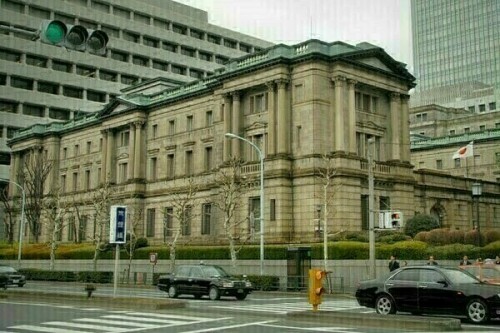Bank of Japan Holds Steady, Downgrades Growth Forecasts
TOKYO: The Bank of Japan (BOJ) has maintained its current interest rate levels while significantly lowering its economic growth predictions on Thursday. This decision reflects concerns that U.S. tariffs and declining exports could prolong the current policy stance.
The central bank anticipates that inflation will generally align with its 2% target in the coming years, indicating that while U.S. tariffs might cause delays, they are not expected to fundamentally alter its plans for future rate increases.
As anticipated, the BOJ’s policy board voted unanimously to keep short-term interest rates stable at -0.1%.
Due to increasing challenges posed by elevated U.S. tariffs, the bank has revised downward its economic growth and inflation projections in its latest quarterly outlook.
However, the BOJ suggests that core inflation should gradually pick up following a period of stagnation, aided by rising wages in a tight labor market. This suggests that the impact of U.S. tariffs is viewed as likely to be temporary.
“The Japanese economy is expected to see moderate growth. However, the pace of growth is likely to slow temporarily due to the impact of trade and other policies,” the BOJ stated.
The BOJ added, “Thereafter, as overseas economies moderately recover, Japan’s economy is projected to grow at a pace above its potential growth rate.”
According to the updated projections, the BOJ has reduced its economic growth forecast for the fiscal year ending March 2026 to 0.5%, down from the 1.1% anticipated three months prior. The forecast for the subsequent fiscal year has also been lowered to 0.7% growth, from the 1.0% projected in January.
The BOJ now projects that core consumer inflation will reach levels aligning with its 2% target around the latter half of fiscal 2026 and beyond, postponing the timeline by approximately one year compared to the previous forecast in January.
The BOJ stated, “If our economic and price forecasts are realized, we will continue to adjust our policy rate.”
Furthermore, the bank noted, “Given extremely high uncertainties regarding trade policies, we will carefully examine economic and price developments, guiding policy without any preconceived notions.”
The BOJ projects core consumer inflation to reach 2.2% in fiscal 2025 and 1.7% in fiscal 2026, before increasing to 1.9% in fiscal 2027.
Izuru Kato, chief economist at Totan Research, commented, “The BOJ appears to be keeping its options open regarding rate hikes. However, it probably wants to maintain flexibility on the timing due to the high level of uncertainty.”
Market participants are closely monitoring Governor Kazuo Ueda’s upcoming press conference for indications on how U.S. tariffs might affect the BOJ’s rate adjustment trajectory.
Impact of Tariffs on Growth
Following the BOJ’s announcement, Japanese government bond yields and the yen experienced declines.
Bart Wakabayashi, Tokyo branch manager at State Street, observed, “Everything’s been reduced in terms of their forecasts and the market seems to be selling the yen at the moment. The BOJ is taking a step back, waiting to see how incoming data reflects the implemented policies.”
Heightened trade tensions stemming from U.S. tariffs have created considerable market volatility and prompted a downward revision in the International Monetary Fund’s global growth outlook.
The BOJ stated in its report that increased tariffs could negatively affect Japan’s economy by impeding global trade and undermining business sentiment through heightened uncertainty and market instability.
The report also suggested that businesses might prioritize cost reduction over wage increases. However, it noted that consistent rises in food costs could indirectly contribute to underlying inflation.
The BOJ expressed a cautiously optimistic long-term view, anticipating that exports, production, and capital expenditure will resume their upward trajectory after a period of temporary slowdown.
Kanako Nakamura, an economist at Daiwa Institute of Research, said, “Domestic wage growth in this year’s labour negotiations is expected to exceed 5%, which will support the case for an additional interest rate hike,” projecting the next hike to occur in the October-December quarter.
The BOJ had previously raised its short-term interest rate to 0.1% in January, based on the expectation that the economy was nearing its 2% inflation goal. While Governor Ueda has indicated the BOJ’s readiness to further adjust rates, U.S. tariffs have introduced complexities to determining the timing and extent of future increases.



Comments (0)
No comments yet. Be the first to comment!
Leave a Comment